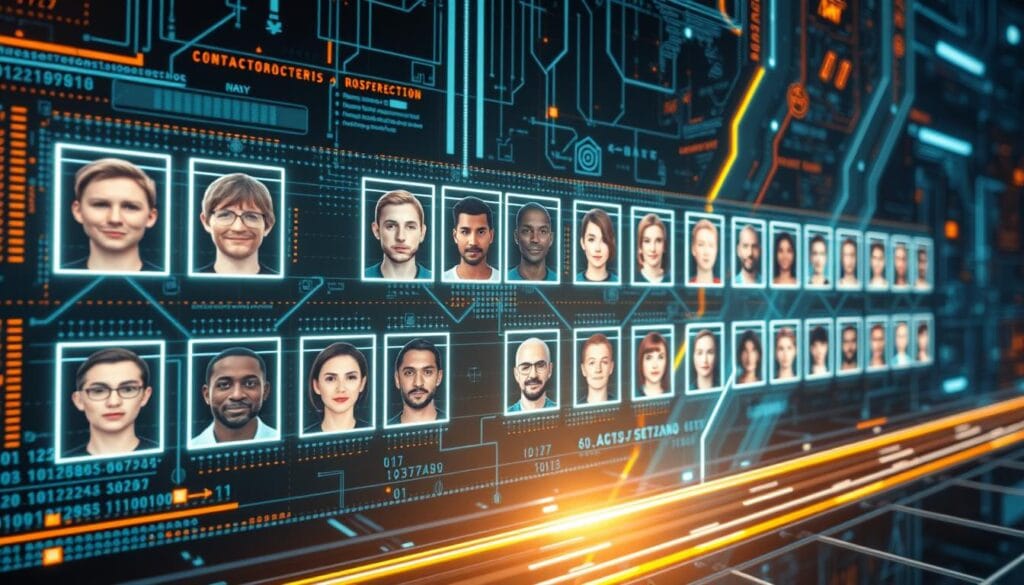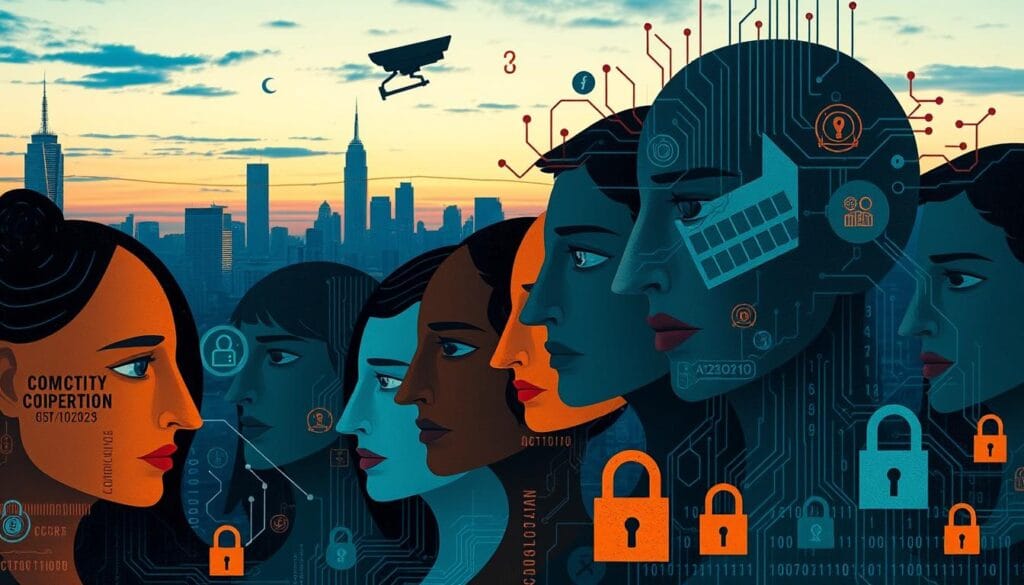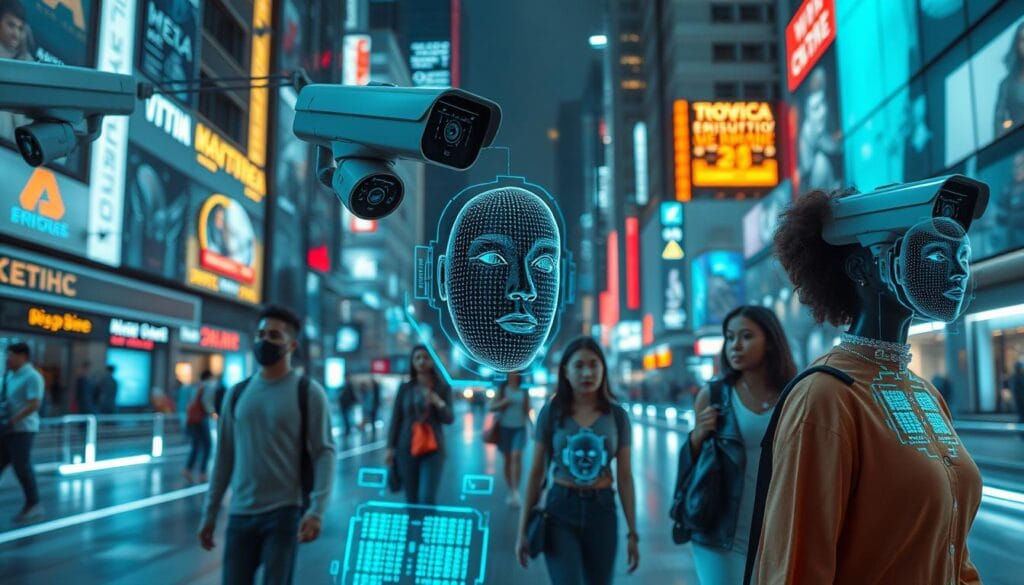Table of Contents
Have you ever looked through old photo albums and seen faces of loved ones come alive? Finding those faces can bring back memories and make us feel safe. Facial recognition search is a new technology that mixes our curiosity with biometric technology. It makes finding faces easy, just like magic.

This system uses biometrics to look at and compare faces with huge databases. It makes finding people easy and fast. In today’s world, we want to keep our memories and stay safe. Face recognition search helps us do both, showing us a future where finding faces is simple.
Key Takeaways
- Facial recognition search uses biometric technology to identify faces.
- This tool analyzes and compares facial features against large databases.
- It enhances both personal and security applications in modern life.
- Facial recognition search bridges past memories with current technology.
- The technology offers a future where every face can be quickly identified.
What is Face Recognition Search?
Face recognition search is a way to identify people by analyzing their faces. It uses face detection software to look at unique facial features. These include the distance between the eyes, nose width, and jawline shape.
Definition of Face Recognition
Face recognition starts with taking a face picture and turning it into numbers—the facial signature. This signature is then checked against a database of known faces. This method, called biometric facial recognition, uses advanced algorithms for accuracy and speed.
How Face Recognition Search Works
The process of facial recognition is complex but interesting. First, a camera takes a picture and uses face detection software to find key facial points. These points are then turned into math data.
This data is searched against a database to find matches. The system’s ability to find matches quickly and accurately makes it very useful. It’s used for unlocking devices, security, and surveillance.
Benefits of Using Face Recognition Search
Using facial recognition technology brings big wins for security and speed. It helps organizations in many ways, from making things safer to making processes smoother.
Enhanced Security
Face recognition search boosts security a lot. It uses unique facial features to identify people accurately. This means no more physical tokens or passwords, cutting down on unauthorized access risks.
Time-Saving Efficiency
It also saves a lot of time. Facial recognition tech quickly checks identities, giving fast results. This speeds up things like airport checks, office access, and smart home entry. It makes everything faster, boosting productivity and user happiness.
Applications of Facial Recognition Technology
Facial recognition technology has changed many fields. It makes things more efficient and secure. It’s used in security and surveillance, and also on social media.
Security and Surveillance
Facial recognition in surveillance systems is a big win for law enforcement. It lets them watch public areas in real time. They can spot people of interest fast.
By using advanced algorithms, they can check faces against huge databases. This makes security better.
Identification in Social Media
Facial recognition is key in social media too. It helps with tagging photos and finding friends. It also keeps accounts safe from hackers.
For users, it means a safer and more personal experience. They can enjoy their favorite platforms without worry.
The Science Behind Face Detection Software
Facial recognition technology has made huge strides. This is thanks to advances in facial recognition algorithms, data processing, and AI face detection. These work together to ensure accurate and reliable face detection.
Algorithms and Data Processing
Face detection software relies on its advanced facial recognition algorithms. These algorithms spot and study facial landmarks, handling huge amounts of image data. They look at each image closely, mapping out facial features to create a unique digital faceprint for each person.
Fast data processing is key for real-time efficiency and accuracy. This is vital for uses like security systems and social media identification.
Machine Learning and AI
Machine learning and AI are crucial for improving face detection software. As the system gets new data, machine learning algorithms get better at detecting faces. This means the software can tell faces apart, even in tough conditions like low light or when faces are partially hidden.
This ability to learn and adapt keeps the software accurate over time. It offers strong and dependable face detection solutions.
Choosing the Best Facial Recognition System
When picking the best facial recognition software, look for key features. These include real-time processing, high accuracy, and an easy-to-use interface. Together, they make facial recognition fast and reliable.
Key Features to Look For
Key features help decide if a facial recognition system is right for you. Here’s what I look for:
- Real-time Processing: This means the system works fast, giving quick results for security and monitoring.
- High Accuracy Rates: High accuracy means fewer mistakes, making the system more trustworthy.
- User-Friendly Interface: An easy interface helps everyone use the system, without needing a lot of training.
Cost and Scalability
It’s important to find a balance between cost and performance. I look for cost-effective facial search options that don’t cut corners on quality. Also, system scalability is key. The system should grow with my needs, handling more users and data without major changes.
- Cost-effective Facial Search: Options that offer good value without sacrificing quality.
- System Scalability: Allows the system to expand smoothly, whether it’s more users or bigger data sets.
By focusing on these features and balancing cost and scalability, I can find the best facial recognition software for my needs.
How Biometric Facial Recognition Enhances Security
Biometric security systems have changed how we control access, protect data, and verify transactions. Face recognition access control is a key part of these systems. It uses unique physical traits to accurately identify people.
These systems check people by their facial features, reducing unauthorized access. This makes security better. Plus, users don’t need to remember passwords or carry cards, making it easier to get in.
Face recognition is useful in many places. It’s great for companies needing secure entry and banks needing strong transaction checks. It adds security without bothering those who should be there.
Implementing a Facial Search Engine
Setting up a facial search engine needs careful planning and attention to detail. It involves deploying facial recognition technology and integrating it with current systems. A detailed strategy is essential.
First, following legal rules is crucial. It’s important to stick to privacy laws like GDPR and CCPA. Not following these can lead to big fines and harm to your reputation.
Next, a strong infrastructure is needed for handling large data. This includes fast servers, enough storage, and tools for data analysis. These are key for managing facial recognition data well.
Here, an overview of crucial components for effective implementation:
- Hardware: High-performance servers and storage solutions
- Software: Advanced data analytics tools and facial recognition algorithms
- Compliance: Adherence to GDPR and CCPA regulations
- Integration: Seamless incorporation into existing IT infrastructure
Lastly, it’s important to teach users how to use the system right. Clear instructions and training help users understand privacy and best practices. This leads to a successful system that meets your needs.
Understanding Facial Recognition Search Algorithms
Facial recognition search algorithms are key to how well these systems work. They use advanced AI to improve face searches from many images. This makes the technology more accurate and trustworthy.
The Role of AI in Search Algorithms
Artificial intelligence is vital for facial recognition tech. AI search algorithms use deep learning to find faces more accurately. They get better with time, thanks to learning from new data.
This learning helps reduce mistakes, making the tech reliable for many uses. It’s great for security and even for finding people on social media.
Error Rates and Accuracy
Knowing about facial recognition errors is important. There are two main types: false positives and false negatives. A false positive is when it finds a wrong match. A false negative is when it misses a correct one.
AI search algorithms work to lower these errors. They aim for better accuracy. As they improve, they give more reliable results.
Ethical Considerations in Facial Recognition
Facial recognition technology is growing fast. But we must talk about its ethics. Privacy, rules, and fairness are key. We need to look closely at how these techs are used and controlled.

Privacy Concerns
One big worry is the misuse of biometric data. Using someone’s face without permission is a big risk. We must protect privacy by being clear about data use and getting consent.
Strong privacy rules help keep people safe. They also help build trust in these technologies.
Regulations and Policies
Rules for facial recognition vary by place. Governments are making laws to help use this tech right. Following these rules is crucial for staying ethical.
Being open and respecting people’s choices is key. This way, we can use facial recognition in a way that’s fair and right.
By focusing on privacy and following rules, we can handle the ethics of facial recognition. This way, we use biometric data in a way that respects people’s rights and values.
Integration of Facial Recognition Software in Everyday Life
Today, facial recognition software is becoming a big part of our lives. It helps keep our devices safe and makes our homes smarter. This tech changes how we live and interact with the world.
Mobile Devices
Smartphones with facial recognition have changed how we use them. Apple and Samsung let us unlock our phones with our faces. It’s safer and makes using our phones easier.
This tech is now a key part of our daily lives. It’s fast, easy, and essential.
Smart Home Systems
Facial recognition has also improved smart home security. Amazon and Google use it in their devices. This makes our homes safer and more convenient.
For example, smart cameras can tell who’s in the house. They know the difference between family and strangers. This makes our homes more secure and tailored to our needs.
| Application | Benefit |
|---|---|
| Mobile Devices | Enhanced security, intuitive access |
| Smart Home Systems | Personalized automation, improved security |
Challenges and Limitations of Facial Recognition Search
Face recognition search has many benefits but also faces big challenges. These include problems with identifying different people and worries about how it might be misused.
Limitations in Diverse Populations
One big problem is how well face recognition works for different people. It often doesn’t work as well for certain groups because the training data isn’t diverse. This can lead to higher error rates for some ethnicities and genders.
For example, studies have found that face recognition systems can wrongly identify people from minority groups more often than those from the majority.
Potential for Misuse
Another big issue is the chance of facial recognition being used in bad ways. Even if it’s meant to help, like making things safer and easier to identify people, it can be misused. This misuse can include things like spying on people without their permission, invading their privacy, and even stealing their identity.
Bias in facial recognition can make these problems worse by unfairly targeting certain groups.
To show the challenges and misuse, here’s a table comparing them for different groups and misuse scenarios.
| Face Recognition Challenges | Potential Misuse Scenarios |
|---|---|
| Higher error rates in identifying diverse populations, especially minority groups | Unauthorized surveillance and invasion of privacy |
| Inaccurate gender recognition | Identity theft and misuse of personal data |
| System bias due to non-diverse training data | Discriminatory practices based on incorrect identifications |
Future Trends in Facial Recognition Technology
The field of facial recognition is growing fast. This is thanks to new tech and more uses for it. We’re seeing big changes coming in this area.
Innovations Ahead
New facial recognition tech will be more accurate and quick. It will use better real-time analytics. Also, new algorithms will help avoid mistakes and work better for everyone.

Experts are working on combining facial recognition with other biometrics. This could change how we identify people. It might make security systems better and easier to use.
Expanding Applications
Facial recognition is getting used in more ways than just security. In healthcare, it will help identify patients and make things run smoother. Retailers can use it to offer better shopping experiences based on what you like.
In cars, facial recognition will help check who’s driving. It will make vehicles safer. Smart cities will use it to manage crowds and plan better.
Here’s a look at how different fields will use these new trends:
| Industry | Application |
|---|---|
| Healthcare | Patient identification, administrative efficiency |
| Retail | Personalized marketing, customer behavior analysis |
| Automotive | Driver authentication, vehicle security |
| Smart Cities | Crowd management, public safety optimization |
With these new uses, facial recognition is getting better. It will make our interactions more efficient and our lives easier in many ways.
Conclusion
Face recognition technology has a big promise for making our lives safer and easier. It can unlock phones, secure places, and even make social media better. But, we must think about its impact on privacy and ethics.
We need to talk a lot and make clear rules for using facial tech. This way, we can enjoy its benefits without losing our privacy and freedom. It’s important to make sure security doesn’t hurt our rights.
Using facial tech wisely means finding a balance between new ideas and being careful. As we move forward, we must protect everyone’s rights. We should focus on innovation that respects ethics and privacy.
FAQ
What is face recognition search?
Face recognition search is a tech that identifies people by their faces. It uses biometrics to match images against databases. It’s used in security and personal ID, and is key in today’s world.
How does face recognition search work?
It works by looking at facial patterns. It checks things like eye distance and jaw shape. Then, it searches databases for a match, helping with things like unlocking phones and finding suspects.
What are the benefits of using face recognition search?
It makes security better and saves time. It’s a reliable way to check who you are without passwords. It’s fast, making things like airport checks quicker.
How is facial recognition technology applied in security and surveillance?
It helps police and security watch public areas. It’s key for keeping places safe and monitored.
Can facial recognition technology be used in social media?
Yes, it’s used for tagging photos and keeping accounts safe. It helps connect friends and protect against unauthorized access.
What is the science behind face detection software?
It uses advanced algorithms and data processing. It finds facial landmarks and learns from new data. This makes it better at recognizing faces over time.
How do I choose the best facial recognition system?
Look for real-time processing, high accuracy, and easy use. Balance cost and performance. Make sure it can grow with your needs.
How does biometric facial recognition enhance security?
It’s a non-intrusive way to verify identities. It’s accurate and reduces unauthorized access. It’s great for keeping data and transactions safe.
What should be considered when implementing a facial search engine?
Plan carefully, following laws and ensuring data security. Give clear instructions and respect privacy. Make sure it fits well with your systems.
How do facial recognition search algorithms work?
They analyze facial patterns and use AI to improve. Knowing error rates is key. Improvements aim to reduce mistakes for better accuracy.
What are the ethical considerations in facial recognition technology?
Privacy is a big concern. Data must be protected. Laws vary, so respect for consent is crucial.
How is facial recognition software integrated into everyday life?
It’s in mobile devices and smart homes for security and convenience. It adapts to your routines, making life easier.
What are the challenges and limitations of facial recognition search?
There are biases and misuse risks. It’s important to use it responsibly. Checks and balances are needed.
What future trends can we expect in facial recognition technology?
Expect better analytics and wider use in industries like healthcare and retail. It will change how we do things.
You can read more tech news by clicking here.
Or you can check our Play Store apps:

